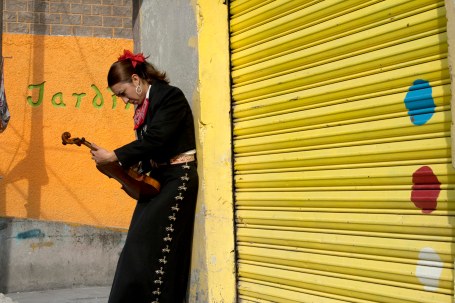Que Caramba Es La Vida: Mill Valley Film Festival 2014
October 3, 2014 at 5:43 pm Leave a comment
The Mill Valley Film Festival’s 2014 edition starts this weekend and as per usual it’s a star-studded affair, with guest appearances by the likes of Hilary Swank, Jason Reitman, Billy Joe Armstrong, Ellie Fanning, Laura Dern, Metallica, and many more Hollywood glitterati. The program also boasts an outstanding lineup of documentaries, including several by local filmmakers, so the reasons for driving across the Golden Gate Bridge (or the Richmond/San Rafael Bridge, depending on your homebase) are manifold.
This year the festival is spotlighting Spanish-language cinema from around the world, including the excellent documentary Que Caramba Es La Vida, an intriguing portrait of the fierce and talented women mariachis of Mexico City. Directed by veteran German filmmaker Doris Dörrie, the movie documents the experiences of several female performers working to make a mark in a field dominated by men. The film is shot mostly verite-style with no narration, as each of the women describes how she came to be a mariachi and why she continues in the business. Some come from mariachi families, with parents or grandparents who performed before them, while others are the first in their families to perform. A particularly compelling story is that of Maria del Carmen, a mariachi singer who lives with her single mom and young daughter in a small apartment in Mexico City. Del Carmen’s mother recalls that even as a girl, her daughter Maria had a voice “that went right through you,” and this is pretty apparent after hearing del Carmen soulfully belt out a couple songs in the Plaza Garabaldi, which is home to scores of mariachi bands plying their trade every night. The film depicts del Carmen’s everyday performance prep routine, as her mom and daughter help her with her makeup and hair, as well as revealing her concerns for her daughter’s future as a female growing up working-class in Mexico. The movie also follows Las Pioneras, a group of older female mariachi groups whose members who are now in their sixties and seventies and who started out as mariachis in the 1950s as teenagers and young women. The last quarter of the movie follows the Dia de los Muertes celebrations in Mexico City, neatly contextualizing the mariachi tradition. Que Caramba Es La Vida effectively looks at some of the social and cultural milieu surrounded the women, including the effects of drug dealers, misogyny, poverty, and crime on their ability to keep performing.
Mexican music of a different sort is profiled in For Those About To Rock: The Story of Rodrigo y Gabriela. Rock journalist and first-time director Alejandro Franco narrates his very accessible portrait of the popular Mexico City guitar duo, from their roots in the capital listening to thrash and heavy metal like Megadeth, Metallica, and Slayer as teenagers. Both subjects are fluent in English and were raised in middle-class Mexican families, so their stories for the most part are very different from their mariachi counterparts in Dörrie’s film. The film is a standard biopic of a successful musical outfit so, unless you’re a big Rodrigo y Gabriela fan, the movie is less compelling than Dorrie’s movie. The film starts out strong, quickly and succinctly contextualizing the Mexico rock music scene, but bogs down in the middle as it becomes a fairly linear recounting of R&G’s career.Although the film is about musicians, one of its shortcoming is that there isn’t actually enough of R&G’s music in the earlier part of film, so if you’re unfamiliar with the duo you might not know what the fuss is all about. The film makes the mistake of telling and not showing, which weakens its impact—there are a lot of talking heads explaining things and not enough things happening instead. Whereas Que Caramba takes place on the streets and in the plazas of Mexico City, For Those About To Rock happens mostly in recording studios, backstage, and at clubs, and concerts, and is more of a fannish tribute about legend-building than an incisive look at the duo. There is also not much dramatic tension—the director refers to the story as a “fairy tale’ and it’s presented as such, with R&G destined to achieve their rock star ambitions. The viewer learns very little about either musician’s personal life or any deep, compelling reasons for why they make music other than “it’s fun”, and the film lacks a strong sense of a cultural context for who they are and where they came from. The film ends with about ten minutes of live concert footage that only underscores the relative paucity of music in the rest of the film, which may be enough of a reason for admirers of Rodrigo y Gabriela to watch the film.
The Mill Valley Film Festival eleven days beginning on Oct. 2 in various theaters in and around Mill Valley. Go here for complete schedule and ticket information.
Entry filed under: Uncategorized.




Trackback this post | Subscribe to the comments via RSS Feed